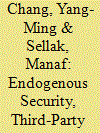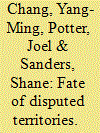| Srl | Item |
| 1 |
ID:
189457


|
|
|
|
|
| Summary/Abstract |
This paper examines third-party trade and its implications for conflicts between hostile countries not engaging in trade. We present a conflict-theoretic model to analyze two adversaries’ endogenous arming decisions when they separately establish a free trade agreement (FTA) with a neutral third-party state. We contrast this multiple FTAs regime with a single FTA regime between one adversary and the third-party state, which excludes the other adversary as a non-member. In our analysis, the benchmark case is a protectionist regime when the bilateral trade between the third-party state and each of the adversaries is a tariff war. Among the three trade regimes, we show that the two adversaries’ aggregate arming is the lowest under multiple FTAs but is the highest under a single FTA. These results suggest that, despite no trade between two adversary countries, multiple FTAs through third-party trade have the pacifying or appeasing effect of lowering overall military buildups in interstate conflicts.
|
|
|
|
|
|
|
|
|
|
|
|
|
|
|
|
| 2 |
ID:
079649


|
|
|
|
|
| Publication |
2007.
|
| Summary/Abstract |
This paper presents a simple model to characterize the outcome of a land dispute between two rival parties using a Stackelberg game. Unlike Gershenson and Grossman (2000), we assume that the opposing parties have access to different technologies for challenging and defending in conflict. We derive the conditions under which territorial conflict between the two parties is less likely to persist indefinitely. Allowing for an exogenous destruction term as in Garfinkel and Skaperdas (2000), we show that, when the nature of conflict becomes more destructive, the likelihood of a peaceful outcome, in which the territory's initial possessor deters the challenging party, increases if the initial possessor holds more intrinsic value for the disputed land. Following Siqueira (2003), our model has policy implications for peace through third-party intervention
|
|
|
|
|
|
|
|
|
|
|
|
|
|
|
|